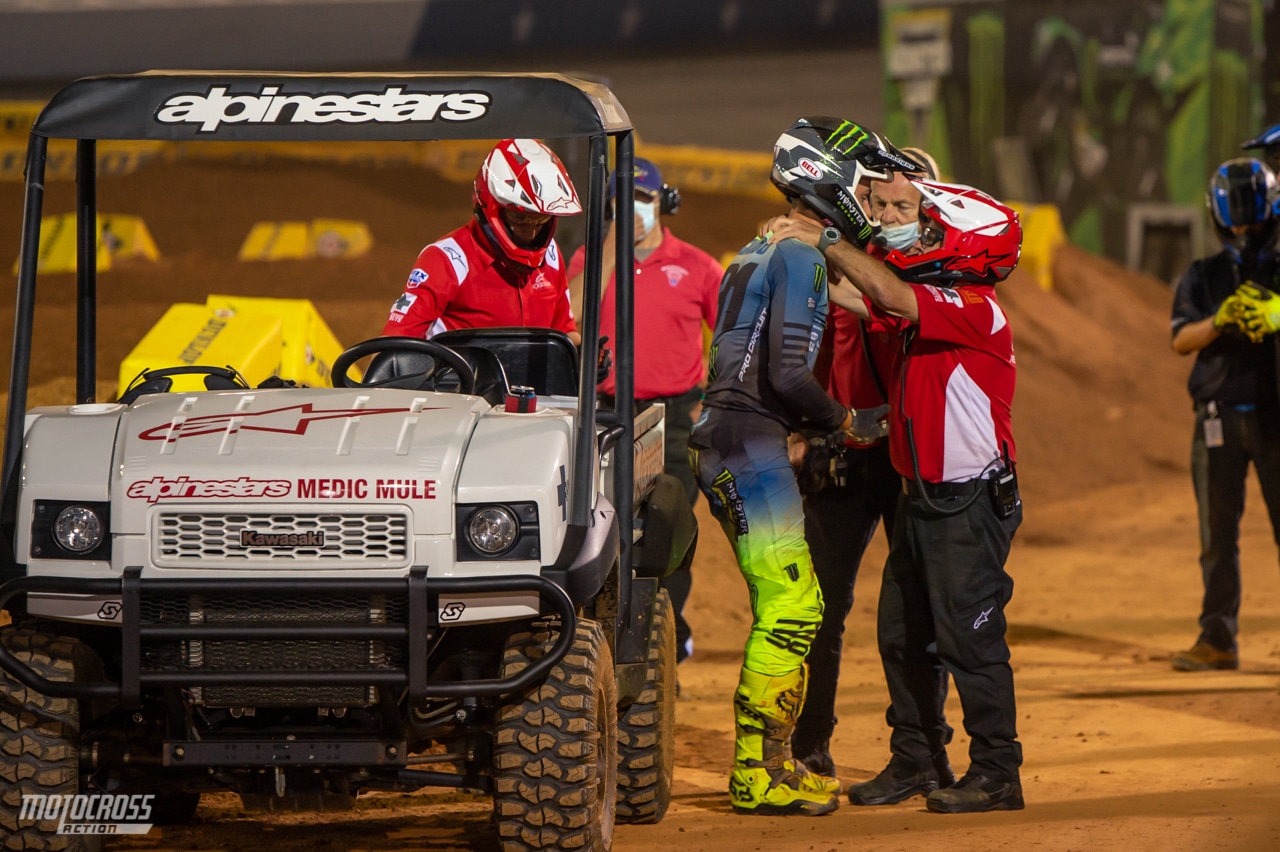TEN THINGS ABOUT THE AMA’S CONCUSSION-MANAGEMENT PROTOCOL
(1) History. Over the years, we have watched many riders suffer traumatic head injuries while racing on live TV. Many times, fans are surprised to see a rider be allowed to lineup for the next moto. Some fans are surprised that the concussion requirements aren’t more stringent, and others are surprised that there is even a concussion-management program in the first place.
(2) Concussion. According to the AMA rulebook, a concussion is “an alteration in brain function related to a direct or indirect blow to the head. Indirect blows can be caused by acceleration and/or deceleration forces. A concussion can cause alterations in cognitive (thought), visual, auditory, vestibular (balance) and other neurological functions.”
 Cameron McAdoo at the 2021 Atlanta Supercross.
Cameron McAdoo at the 2021 Atlanta Supercross.
(3) Testing. The AMA Supercross and Pro Motocross series share the same concussion-management program using the Alpinestars Mobile Medical Unit and the ImPACT computerized test that was designed to support trained healthcare providers in making the proper “return to activity” decisions following concussions. The ImPACT test is an FDA-cleared medical test that measures memory, attention span, and visual and verbal problem-solving to determine the quality of brain function.
(4) Baseline. Riders must take a baseline pre-season neurocognitive ImPACT test to get their AMA Pro license. Step one is to take the 30-minute computer-based exam (there is no pass/fail score). The rider can take it at home. The pre-season ImPACT test is used to compare pre-injury results with a post-injury test to determine if the brain has been damaged by the recent crash.
 Max Vohland crashes at Red Bull Straight Rhythm in 2019.
Max Vohland crashes at Red Bull Straight Rhythm in 2019.
(5) Evaluation. If a concussion is suspected while at a race, the rider is required to go directly to the Alpinestars Mobile Medical Unit. The athlete is not allowed to return to practice and/or racing until additional testing is performed. If a concussion is confirmed, the athlete is disqualified for that day and placed into the concussion and “return to ride” rules protocol. Additionally, if information is obtained that an out-of-competition practice crash has occurred, the athlete will also be required to present for evaluation and possible inclusion into the concussion protocol.
(6) Honor system. Sadly, the concussion-management system isn’t foolproof. With over 100 riders on the track at every event, it is nearly impossible for the Alpinestars Mobile Medics to follow up with every rider who hits his head in a crash. Unless the accident is caught on TV, it’s usually up to the riders to admit themselves into the medic’s care; however, many riders won’t come clean when they hit their head for fear they could miss races, lose points in the Championship or potentially lose their ride.
 Yamaha rookie Levi Kitchen at the 2022 Arlington Supercross.
Yamaha rookie Levi Kitchen at the 2022 Arlington Supercross.
(7) Protocol. The concussion protocol requires the athlete to first be evaluated by a physician (MD or DO) experienced in the evaluation and treatment of sports-related concussions. Second, the rider must submit to post-injury ImPACT neurocognitive testing with comparison to the baseline test. Third, he must participate in a supervised, graded, motocross-specific exercise and riding program under the evaluating physician.
(8) Exercise program. Because it is impossible (without hiring physicians to travel home with each rider) for the medics to monitor each athlete’s head injury, it is up to the rider, his team and his support crew to determine if the rider’s brain is ready to return to riding and racing again. If the athlete passes his online test, he is supposed to try a workout in the gym to make sure he doesn’t get dizzy when his heart rate rises. If he gets dizzy, that is a clear sign that the brain has not healed, and the athlete is not ready to risk crashing again.
 Mike Alessi at the 2022 Wiseco World Two-Stroke Championship.
Mike Alessi at the 2022 Wiseco World Two-Stroke Championship.
(9) Lower standard. The baseline test must be taken every two years. Some riders will intentionally flunk their baseline test by answering the questions slowly or incorrectly to lower their personal cognitive standard. Then, if they are subjected to a post-concussion test mid-season, it’s easier for them to achieve the same result and limit the risk of missing a race. Another option for the rider is to have someone else complete the post-concussion online test; however, the rider is really only cheating himself and endangering his future health by doing this.
(10) GoPro. To increase safety, the AMA rulebook was updated before the 2021 season to prohibit all cameras, devices or accessories of any type from being mounted to the rider’s helmet. Any accessory mounted to your helmet can only have negative effects in a crash, because it can affect the way the helmet deflects and absorbs energy. Sadly, multiple riders have been seriously injured while wearing a helmet camera, although it is difficult to assign blame.






Comments are closed.